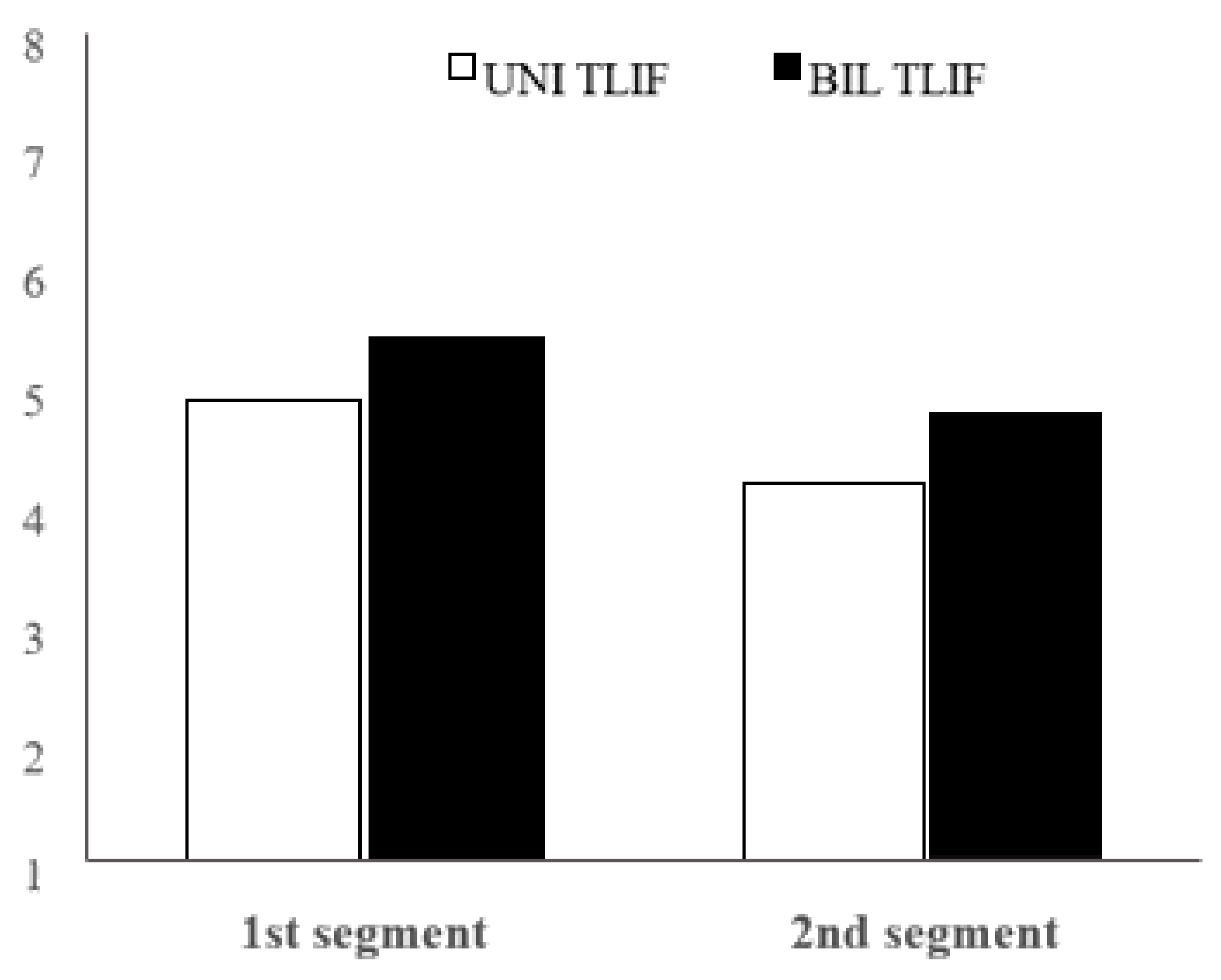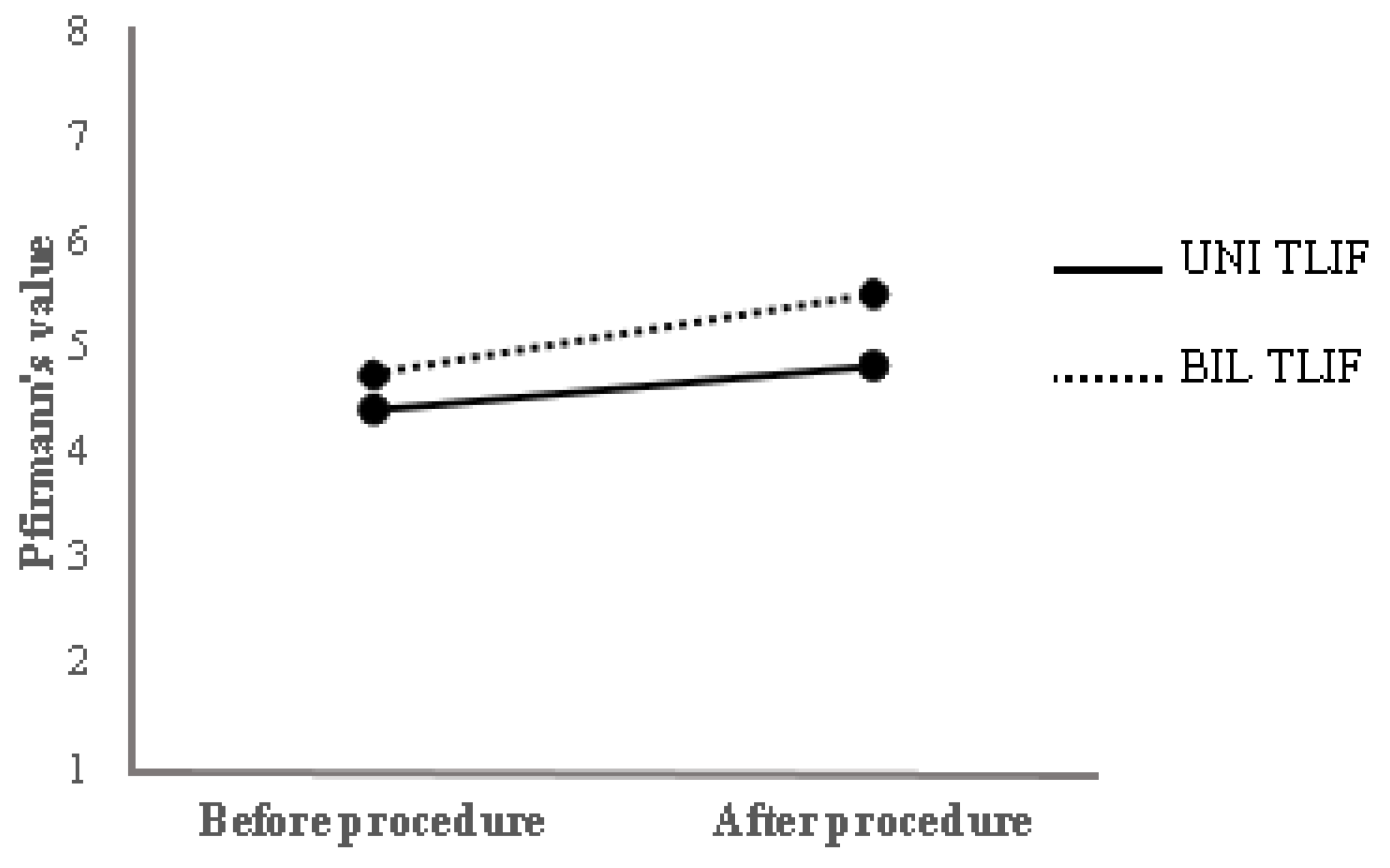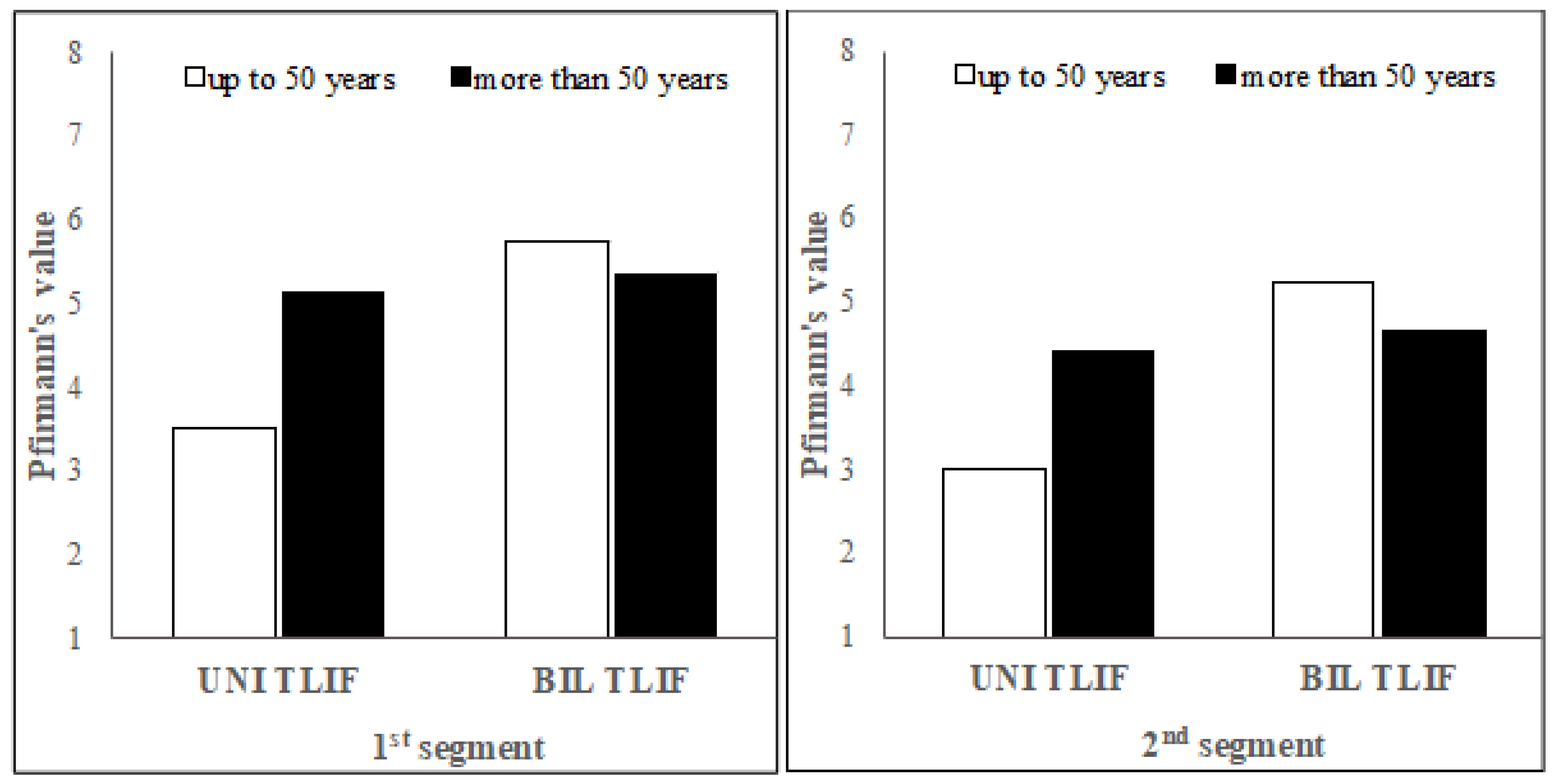MRI Assessment of the Early Disc Degeneration Two Levels above Fused Lumbar Spine Segment: A Comparison after Unilateral and Bilateral Transforaminal Lumbar Interbody Fusion (TLIF) Procedure
Abstract
1. Introduction
2. Methods
3. Results
4. Discussion
5. Conclusions
Author Contributions
Funding
Institutional Review Board Statement
Informed Consent Statement
Conflicts of Interest
References
- DePalma, M.J.; Ketchum, J.M.; Saullo, T. What is the source of chronic low back pain and does age play a role? Pain Med. 2011, 12, 224–233. [Google Scholar] [CrossRef] [PubMed]
- Chen, D.-J.; Yao, C.; Song, Q.; Tang, B.; Liu, X.; Zhang, B.; Dai, M.; Nie, T.; Wan, Z. Unilateral versus Bilateral Pedicle Screw Fixation Combined with Transforaminal Lumbar Interbody Fusion for the Treatment of Low Lumbar Degenerative Disc Diseases: Analysis of Clinical and Radiographic Results. World Neurosurg. 2018, 115, e516–e522. [Google Scholar] [CrossRef] [PubMed]
- Slucky, A.V.; Brodke, D.S.; Bachus, K.N.; Droge, J.A.; Braun, J.T. Less invasive posterior fixation method following transforaminal lumbar interbody fusion: A biomechanical analysis. Spine J. 2006, 6, 78–85. [Google Scholar] [CrossRef] [PubMed]
- Fernández-Fairen, M.; Sala, P.; Ramírez, H.; Gil, J. A prospective randomized study of unilateral versus bilateral instrumented posterolateral lumbar fusion in degenerative spondylolisthesis. Spine 2007, 32, 395–401. [Google Scholar] [CrossRef] [PubMed]
- Lee, M.J.; Dettori, J.R.; Standaert, C.J.; Ely, C.G.; Chapman, J.R. Indication for spinal fusion and the risk of adjacent segment pathology: Does reason for fusion affect risk? A systematic review. Spine 2012, 37 (Suppl. 22), S40–S51. [Google Scholar] [CrossRef] [PubMed]
- Badikillaya, V.; Akbari, K.K.; Sudarshan, P.; Suthar, H.; Venkatesan, M.; Hegde, S.K. Comparative Analysis of Unilateral versus Bilateral Instrumentation in TLIF for Lumbar Degenerative Disorder: Single Center Large Series. Int. J. Spine Surg. 2021, 15, 929–936. [Google Scholar] [CrossRef] [PubMed]
- Lee, C.S.; Hwang, C.J.; Lee, S.-W.; Ahn, Y.-J.; Kim, Y.-T.; Lee, D.-H.; Lee, M.Y. Risk factors for adjacent segment disease after lumbar fusion. Eur. Spine J. 2009, 18, 1637–1643. [Google Scholar] [CrossRef]
- Wang, T.; Ding, W. Risk factors for adjacent segment degeneration after posterior lumbar fusion surgery in treatment for degenerative lumbar disorders: A meta-analysis. J. Orthop. Surg. Res. 2020, 15, 582. [Google Scholar] [CrossRef]
- Griffith, J.F.; Wang, Y.-X.; Antonio, G.E.; Choi, K.C.; Yu, A.; Ahuja, A.T.; Leung, P.C. Modified Pfirrmann grading system for lumbar intervertebral disc degeneration. Spine 2007, 32, E708–E712. [Google Scholar] [CrossRef]
- Fan, S.-W.; Zhou, Z.-J.; Hu, Z.-J.; Fang, X.-Q.; Zhao, F.-D.; Zhang, J. Quantitative MRI analysis of the surface area, signal intensity and MRI index of the central bright area for the evaluation of early adjacent disc degeneration after lumbar fusion. Eur. Spine J. 2012, 21, 1709–1715. [Google Scholar] [CrossRef][Green Version]
- Salamat, S.; Hutchings, J.; Kwong, C.; Magnussen, J.; Hancock, M.J. The relationship between quantitative measures of disc height and disc signal intensity with Pfirrmann score of disc degeneration. Springerplus 2016, 5, 829. [Google Scholar] [CrossRef]
- Videman, T.; Battie, M.C.; Gibbons, L.E.; Gill, K. A new quantitative measure of disc degeneration. Spine J. 2017, 17, 746–753. [Google Scholar] [CrossRef] [PubMed]
- Byvaltsev, V.; Kalinin, A.; Giers, M.; Shepelev, V.; Pestryakov, Y.; Biryuchkov, M. Comparison of MRI Visualization Following Minimally Invasive and Open TLIF: A Retrospective Single-Center Study. Diagnostics 2021, 11, 906. [Google Scholar] [CrossRef] [PubMed]
- Rečnik, G. Progressive muscle weakness due to lumbar disc herniation in pregnancy: A case report. Acta Med. Bioteh. 2017, 10, 58–62. [Google Scholar]
- Molinari, R.W.; Saleh, A.; Molinari, R., Jr.; Hermsmeyer, J.; Dettori, J.R. Unilateral versus Bilateral Instrumentation in Spinal Surgery: A Systematic Review. Glob. Spine J. 2015, 5, 185–194. [Google Scholar] [CrossRef]
- Shen, X.; Zhang, H.; Gu, X.; Gu, G.; Zhou, X.; He, S. Unilateral versus bilateral pedicle screw instrumentation for single-level minimally invasive transforaminal lumbar interbody fusion. J. Clin. Neurosci. 2014, 21, 1612–1616. [Google Scholar] [CrossRef]
- Zhang, K.; Sun, W.; Zhao, C.Q.; Li, H.; Ding, W.; Xie, Y.; Sun, X.; Zhao, J. Unilateral versus bilateral instrumented transforaminal lumbar interbody fusion in two-level degenerative lumbar disorders: A prospective randomised study. Int. Orthop. 2014, 38, 111–116. [Google Scholar]
- Choi, U.Y.; Park, J.Y.; Kim, K.H.; Kuh, S.U.; Chin, D.K.; Kim, K.S.; Cho, Y.E. Unilateral versus bilateral percutaneous pedicle screw fixation in minimally invasive transforaminal lumbar interbody fusion. Neurosurg. Focus. 2013, 35, E11. [Google Scholar] [CrossRef]
- Nam, W.D.; Cho, J.H. The importance of proximal fusion level selection for outcomes of multi-level lumbar posterolateral fusion. Clin. Orthop. Surg. 2015, 7, 77–84. [Google Scholar] [CrossRef][Green Version]
- Carreon, L.Y.; Puno, R.M.; Dimar, J.R., 2nd; Glassman, S.D.; Johnson, J.R. Perioperative complications of posterior lumbar decompression and arthrodesis in older adults. J. Bone Joint Surg. Am. 2003, 85, 2089–2092. [Google Scholar] [CrossRef]
- Liu, Z.; Fei, Q.; Wang, B.; Lv, P.; Chi, C.; Yang, Y.; Zhao, F.; Lin, J.; Ma, Z. A meta-analysis of unilateral versus bilateral pedicle screw fixation in minimally invasive lumbar interbody fusion. PLoS ONE 2014, 9, e111979. [Google Scholar] [CrossRef] [PubMed]
- Chen, S.-H.; Lin, S.-C.; Tsai, W.-C.; Wang, C.-W.; Chao, S.-H. Biomechanical comparison of unilateral and bilateral pedicle screws fixation for transforaminal lumbar interbody fusion after decompressive surgery—A finite element analysis. BMC Musculoskelet. Disord. 2012, 13, 72. [Google Scholar] [CrossRef] [PubMed]
- Imagama, S.; Kawakami, N.; Kanemura, T.; Tsuji, T.; Ohara, T.; Katayama, Y.; Ishiguro, N.; Kanemura, T. Radiographic Adjacent Segment Degeneration at Five Years After L4/5 Posterior Lumbar Interbody Fusion.With Pedicle Screw Instrumentation: Evaluation by Computed Tomography and Annual Screening With Magnetic Resonance Imaging. J. Spinal Disord. Technol. 2013, 29, E442–E451. [Google Scholar]
- Suk, K.S.; Lee, H.M.; Kim, N.H.; Ha, J.W. Unilateral versus bilateral pedicle screw fixation in lumbar spinal fusion. Spine 2000, 25, 1843–1847. [Google Scholar] [CrossRef] [PubMed]
- Kröner, A.H.; Eyb, R.; Lange, A.; Lomoschitz, K.; Mahdi, T.; Engel, A. Magnetic resonance imaging evaluation of posterior lumbar interbody fusion. Spine 2006, 31, 1365–1371. [Google Scholar] [CrossRef]
- Ding, W.; Chen, Y.; Liu, H.; Wang, J.; Zheng, Z. Comparison of unilateral versus bilateral pedicle screw fixation in lumbar interbody fusion: A meta-analysis. Eur. Spine J. 2014, 23, 395–403. [Google Scholar] [CrossRef]
- Han, Y.C.; Liu, Z.Q.; Wang, S.J.; Li, L.; Tan, J. Comparison of unilateral versus bilateral pedicle screw fixation in degenerative lumbar diseases: A meta-analysis. Eur. Spine J. 2014, 23, 974–984. [Google Scholar] [CrossRef]
- Harms, J.; Rolinger, H. A one-stager procedure in operative treatment of spondylolistheses: Dorsal traction-reposition and anterior fusion (author’s transl). Z. Orthop. Ihre Grenzgeb. 1982, 120, 343–347. [Google Scholar] [CrossRef]
- den Boogert, H.F.; Keers, J.C.; Marinus Oterdoom, D.L.; Kuijlen, J.M.A. Bilateral versus unilateral interlaminar approach for bilateral decompression in patients with single-level degenerative lumbar spinal stenosis: A multicenter retrospective study of 175 patients on postoperative pain, functional disability, and patient satisfaction. J. Neurosurg. Spine 2015, 23, 326–335. [Google Scholar]
- Villavicencio, A.T.; Serxner, B.J.; Mason, A.; Nelson, E.L.; Rajpal, S.; Faes, N.; Burneikiene, S. Unilateral and bilateral pedicle screw fixation in transforaminal lumbar interbody fusion: Radiographic and clinical analysis. World Neurosurg. 2015, 83, 553–559. [Google Scholar] [CrossRef]
- Kim, T.-H.; Lee, B.H.; Moon, S.-H.; Lee, S.-H.; Lee, H.-M. Comparison of adjacent segment degeneration after successful posterolateral fusion with unilateral or bilateral pedicle screw instrumentation: A minimum 10-year follow-up. Spine J. 2013, 13, 1208–1216. [Google Scholar] [CrossRef] [PubMed]
- Maruenda, J.; Barrios, C.; GAribo, F.; Maruenda, B. Adjacent segment degeneration and revision surgery after circumferential lumbar fusion: Outcomes throughout 15 years of follow-up. Eur. Spine J. 2016, 25, 1550–1557. [Google Scholar] [CrossRef] [PubMed]
- Muthu, S.; Chellamuthu, G. How Safe Is Unilateral Pedicle Screw Fixation in Lumbar Fusion Surgery for Management of 2-Level Lumbar Degenerative Disorders Compared with Bilateral Pedicle Screw Fixation? Meta-analysis of Randomized Controlled Trials. World Neurosurg. 2020, 140, 357–368. [Google Scholar] [CrossRef] [PubMed]



| UNI TLIF (n = 25) | BIL TLIF (n = 90) | Mann–Whitney Test | ||||
|---|---|---|---|---|---|---|
| M | SD | M | SD | U | p | |
| 1st segment | 4.88 | 1.130 | 5.42 | 1.390 | 889.5 | 0.102 |
| 2nd segment | 4.20 | 1.000 | 4.79 | 1.276 | 834.0 | 0.042 |
| Before Procedure | After Procedure | Wilcoxon Signed-Rank Test | |||||
|---|---|---|---|---|---|---|---|
| M | SD | M | SD | n | Z | p | |
| UNI TLIF | 4.42 | 1.084 | 4.83 | 1.115 | 12 | −2.236 | 0.025 |
| BIL TLIF | 4.74 | 1.482 | 5.51 | 1.420 | 43 | −4.412 | 0.000 |
| Up to 50 Years | More than 50 Years | Mann–Whitney Test | ||||||
|---|---|---|---|---|---|---|---|---|
| n | M | SD | n | M | SD | U | p | |
| 1st segment | ||||||||
| UNI TLIF | 4 | 3.50 | 0.577 | 21 | 5.14 | 1.014 | 8.0 | 0.009 |
| BIL TLIF | 18 | 5.72 | 1.406 | 72 | 5.35 | 1.386 | 544.0 | 0.284 |
| 2nd segment | ||||||||
| UNI TLIF | 4 | 3.00 | 0.816 | 21 | 4.43 | 0.870 | 10.5 | 0.013 |
| BIL TLIF | 18 | 5.22 | 1.309 | 72 | 4.68 | 1.254 | 516.5 | 0.173 |
| Up to 5 Years | More than 5 Years | Mann–Whitney Test | ||||||
|---|---|---|---|---|---|---|---|---|
| n | M | SD | n | M | SD | U | p | |
| 1st segment | ||||||||
| UNI TLIF | 23 | 4.78 | 1.085 | 2 | 6.00 | 1.414 | 11.0 | 0.211 |
| BIL TLIF | 83 | 5.41 | 1.362 | 7 | 5.57 | 1.813 | 275.0 | 0.811 |
| 2nd segment | ||||||||
| UNI TLIF | 23 | 4.22 | 0.998 | 2 | 4.00 | 1.414 | 20.5 | 0.790 |
| BIL TLIF | 83 | 4.77 | 1.262 | 7 | 5.00 | 1.528 | 236.5 | 0.403 |
Publisher’s Note: MDPI stays neutral with regard to jurisdictional claims in published maps and institutional affiliations. |
© 2022 by the authors. Licensee MDPI, Basel, Switzerland. This article is an open access article distributed under the terms and conditions of the Creative Commons Attribution (CC BY) license (https://creativecommons.org/licenses/by/4.0/).
Share and Cite
Dujic, M.K.; Recnik, G.; Milcic, M.; Bosnjak, E.; Rupreht, M. MRI Assessment of the Early Disc Degeneration Two Levels above Fused Lumbar Spine Segment: A Comparison after Unilateral and Bilateral Transforaminal Lumbar Interbody Fusion (TLIF) Procedure. J. Clin. Med. 2022, 11, 3952. https://doi.org/10.3390/jcm11143952
Dujic MK, Recnik G, Milcic M, Bosnjak E, Rupreht M. MRI Assessment of the Early Disc Degeneration Two Levels above Fused Lumbar Spine Segment: A Comparison after Unilateral and Bilateral Transforaminal Lumbar Interbody Fusion (TLIF) Procedure. Journal of Clinical Medicine. 2022; 11(14):3952. https://doi.org/10.3390/jcm11143952
Chicago/Turabian StyleDujic, Milka Kljaic, Gregor Recnik, Milko Milcic, Eva Bosnjak, and Mitja Rupreht. 2022. "MRI Assessment of the Early Disc Degeneration Two Levels above Fused Lumbar Spine Segment: A Comparison after Unilateral and Bilateral Transforaminal Lumbar Interbody Fusion (TLIF) Procedure" Journal of Clinical Medicine 11, no. 14: 3952. https://doi.org/10.3390/jcm11143952
APA StyleDujic, M. K., Recnik, G., Milcic, M., Bosnjak, E., & Rupreht, M. (2022). MRI Assessment of the Early Disc Degeneration Two Levels above Fused Lumbar Spine Segment: A Comparison after Unilateral and Bilateral Transforaminal Lumbar Interbody Fusion (TLIF) Procedure. Journal of Clinical Medicine, 11(14), 3952. https://doi.org/10.3390/jcm11143952






